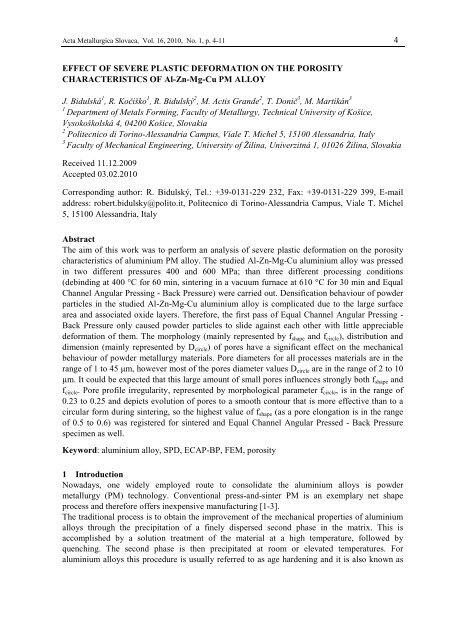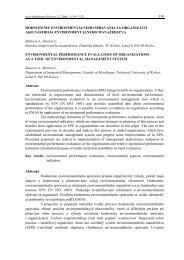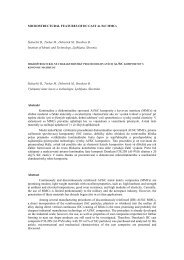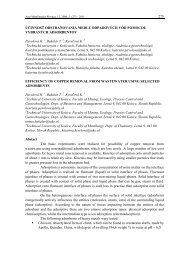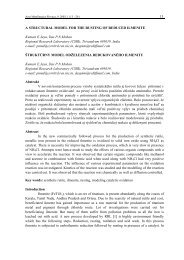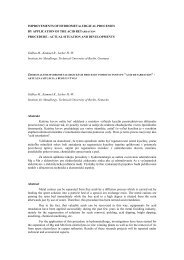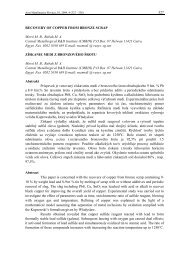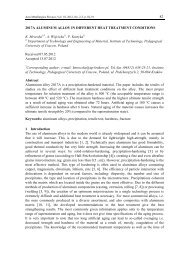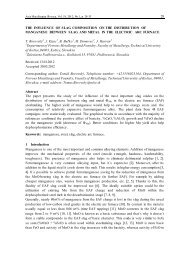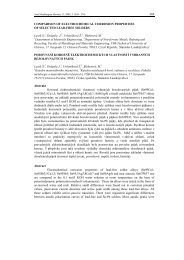4 EFFECT OF SEVERE PLASTIC DEFORMATION ON THE ...
4 EFFECT OF SEVERE PLASTIC DEFORMATION ON THE ...
4 EFFECT OF SEVERE PLASTIC DEFORMATION ON THE ...
You also want an ePaper? Increase the reach of your titles
YUMPU automatically turns print PDFs into web optimized ePapers that Google loves.
Acta Metallurgica Slovaca, Vol. 16, 2010, No. 1, p. 4-11 4<strong>EFFECT</strong> <strong>OF</strong> <strong>SEVERE</strong> <strong>PLASTIC</strong> <strong>DEFORMATI<strong>ON</strong></strong> <strong>ON</strong> <strong>THE</strong> POROSITYCHARACTERISTICS <strong>OF</strong> Al-Zn-Mg-Cu PM ALLOYJ. Bidulská 1 , R. Kočiško 1 , R. Bidulský 2 , M. Actis Grande 2 , T. Donič 3 , M. Martikán 31Department of Metals Forming, Faculty of Metallurgy, Technical University of Košice,Vysokoškolská 4, 04200 Košice, Slovakia2 Politecnico di Torino-Alessandria Campus, Viale T. Michel 5, 15100 Alessandria, Italy3Faculty of Mechanical Engineering, University of Žilina, Univerzitná 1, 01026 Žilina, SlovakiaReceived 11.12.2009Accepted 03.02.2010Corresponding author: R. Bidulský, Tel.: +39-0131-229 232, Fax: +39-0131-229 399, E-mailaddress: robert.bidulsky@polito.it, Politecnico di Torino-Alessandria Campus, Viale T. Michel5, 15100 Alessandria, ItalyAbstractThe aim of this work was to perform an analysis of severe plastic deformation on the porositycharacteristics of aluminium PM alloy. The studied Al-Zn-Mg-Cu aluminium alloy was pressedin two different pressures 400 and 600 MPa; than three different processing conditions(debinding at 400 °C for 60 min, sintering in a vacuum furnace at 610 °C for 30 min and EqualChannel Angular Pressing - Back Pressure) were carried out. Densification behaviour of powderparticles in the studied Al-Zn-Mg-Cu aluminium alloy is complicated due to the large surfacearea and associated oxide layers. Therefore, the first pass of Equal Channel Angular Pressing -Back Pressure only caused powder particles to slide against each other with little appreciabledeformation of them. The morphology (mainly represented by f shape and f circle ), distribution anddimension (mainly represented by D circle ) of pores have a significant effect on the mechanicalbehaviour of powder metallurgy materials. Pore diameters for all processes materials are in therange of 1 to 45 µm, however most of the pores diameter values D circle are in the range of 2 to 10µm. It could be expected that this large amount of small pores influences strongly both f shape andf circle . Pore profile irregularity, represented by morphological parameter f circle , is in the range of0.23 to 0.25 and depicts evolution of pores to a smooth contour that is more effective than to acircular form during sintering, so the highest value of f shape (as a pore elongation is in the rangeof 0.5 to 0.6) was registered for sintered and Equal Channel Angular Pressed - Back Pressurespecimen as well.Keyword: aluminium alloy, SPD, ECAP-BP, FEM, porosity1 IntroductionNowadays, one widely employed route to consolidate the aluminium alloys is powdermetallurgy (PM) technology. Conventional press-and-sinter PM is an exemplary net shapeprocess and therefore offers inexpensive manufacturing [1-3].The traditional process is to obtain the improvement of the mechanical properties of aluminiumalloys through the precipitation of a finely dispersed second phase in the matrix. This isaccomplished by a solution treatment of the material at a high temperature, followed byquenching. The second phase is then precipitated at room or elevated temperatures. Foraluminium alloys this procedure is usually referred to as age hardening and it is also known as
Acta Metallurgica Slovaca, Vol. 16, 2010, No. 1, p. 4-11 5precipitation hardening [4]. In the past decade, the research focused on the strengthening of Alalloys without any ageing treatment, via severe plastic deformation (SPD) [4-6]. Representingone of severe plastic deformation methods, Equal Channel Angular Pressing (ECAP) is rathereffective for producing ultrafine-grained (UFG) metals with enhanced mechanical andprocessing properties inherent in various UFG materials [7, 8]. The ECAP process is apromising method that involves large shear plastic deformation in a deforming layer of aworkpiece. The application of back-pressure leads to a suppressing of damage accumulation andclosure of defects, while the absence of back-pressure leads to the development of defects due tosevere plastic deformation [9]. Authors [10] report that conventional forming methods and heattreatment can determine a limit in the level of strength-plastic characteristics adequate tostructural properties in aluminium alloys. Presented results underline that a combination of highstrength and ductility of ultrafine polycrystalline metals prepared by severe plastic deformationis unique and it indeed represents a interesting case from the point of view of mechanicalproperties, as confirmed in [11, 12].Most of the properties of PM materials are strongly related to porosity. The pores act as crackinitiators and due to their presence distribution of stress is inhomogeneous across the crosssection and leads to reduction of the effective load bearing area. Both the morphology anddistribution of pores have a significant effect on the mechanical behaviour of PM materials. Theeffect of porosity on the mechanical properties depends on several factors such as the quantity ofpores, their interconnection, size, morphology and distribution [13]. Moreover, also the chemicalcomposition the lubricant used the die design and the sintering parameters (atmosphere,temperature and time) impact on the influence of pores onto the components’ characteristics.In order to evaluate powder behaviour in nanoscale, some new approaches are necessary [14], aswell as mathematical and computer simulation [15-18].The aim of this work was to perform an analysis of severe plastic deformation on the porositycharacteristics of aluminium PM alloy.2 Material and experimental methodsThe material used in this experiment was an aluminium alloy ALUMIX 431 (Al-5.5 wt.% Zn-2.5 wt.% Mg- 1.6 wt.% Cu- 1.0 wt.% Wax) supplied by Ecka Granules – Metal PowderTechnologies.Specimens were obtained using a 2000 kN hydraulic press, applying two different pressures(400 and 600 MPa). Unnotched impact energy specimens 55×10×10 mm 3 (ISO 5754) wereprepared. Specimens were debinded in a ventilated furnace (Nabertherm) at 400 °C for 60 min.Sintering was carried out in a vacuum furnace (TAV) at 610 °C for 30 min, with an appliedcooling rate (post sintering) of 6 °C/s. The set-up of ECAP-BP for the produced PM materialsconsisted of a vertical entrance channel with a forward pressing plunger and a horizontal exitchannel with a back plunger providing a constant back pressure during pressing. The die had a90° angle with sharp corners and channels of 6×6 mm 2 in the cross section. Specimens were theninserted in the entrance channel with graphite lubrication. A heating device was employed toheat the die to 250 °C, which was kept under control to ±1 °C through a thermocouple mountedclose to the intersection of the channels. A back pressure of 100 MPa was used. The specimenswere ECAPed-BP for 1 pass. The processing conditions are presented in Table 1.The metallographic specimens were impregnated with resin under vacuum in order to avoid anypore distortion during polishing. The microstructural characterization was carried out onunetched specimens using an optical microscope LEICA MPEF4 equipped with an image
Acta Metallurgica Slovaca, Vol. 16, 2010, No. 1, p. 4-11 6analyzer and SEM Jeol 7000F. Characterization was carried out at ×200 on the minimum 10different image fields; this way, over 2000 pores were recorded and processed by Leica Qwinimage analysis system.Table 1 The processing conditions for studied aluminium alloyNo Pressure [MPa] Processing conditions1a 400 debinding1b 600 debinding2a 400 debinding, ECAP-BP2b 600 debinding, ECAP-BP3a 400 debinding, sintering, ECAP-BP3b 600 debinding, sintering, ECAP-BPThe following parameters were measured individually for each pore to describe the dimensionaland morphological characteristics, such as D circle (the diameter of the equivalent circle that hasthe same area as the metallographic cross-section of the pore) and morphological characteristicsf shape and f circle which reflect form of the pores. The measured values of f shape and f circle were alldivided by a correction factor of 1.064 according to recommendation by authors [19]. Thecalculations of both parameters are reported as follows:f Dmin= [ −]shape Dmax(1)whereD min [µm] the parameter representing minimum of Feret diameter;D max [µm] the parameter representing maximum of Feret diameter;andf circle4⋅π⋅ A=2P[ −](2)whereA [µm 2 ] the area of the metallographic cross-section of the poreP [µm] the perimeter of the metallographic cross-section of the pore.Two dimensional plane-strain finite element simulations of ECAP-BP were performed using thecommercial program Deform 2D. A workpiece was defined as a porous material with apparentdensity of 0.604; as well as an elasto-plastic material with Al 6062 database characteristics. Thetools of press and ECAP equipment (the die and plunger) were assumed to be rigid materials andthey were assigned of tool steel material characteristic, being much higher than those ofdeformed material. Porosity distribution of as-pressed workpiece was directly interpolated toECAP-BP workpiece. Subsequently, the workpiece was ECAPed and the back pressure wasapplied through a back pressing ram by edge force of 100 MPa.3 Experimental results and discussion3.1 Sintering conditionsLiquid phase sintering consists of typical stages. During the heating stage, the penetration of thepressing contacts by the transient liquid eutectic phases results in a pronounced expansion within
Acta Metallurgica Slovaca, Vol. 16, 2010, No. 1, p. 4-11 7a rather small temperature interval. During further heating, when the solidus temperature for thecomposition is exceeded, also persistent liquid phase is formed, resulting in fast shrinkage.Depending on the selected heating rate and sintering temperature, the ratio solid-liquid variesand also the shrinkage does. The very sensitive solid-liquid equilibrium results in tightrequirements for the tolerable temperature interval. It is well-known that for an effective liquidphase sintering, a wetting liquid represents an essential requirement. Authors [20-22] suggestedthat the Al-CuAl 2 eutectic can wet Al 2 O 3 at 600 °C. However, not even Mg additions to melt Alreduce the contact angle sufficiently to produce wetting. This is possibly the main reason whysintering Al-Zn-Mg-Cu aluminium alloys still can be considered not that easy.It should be noticed, that investigated microstructures present the regions with alloying elementswith high chemical activity, e.g. Cu and Mg, Figs. 1 and 2.Fig.1 The typical microstructure for 400 MPa pressed specimens, a) SEI and b) COMP<strong>OF</strong>ig.2 The typical microstructure for 600 MPa pressed specimens, a) SEI and b) COMPOMainly, Mg from the masteralloy particles is concentrated around the pores and in the necksvolume. It appears that the primary porosity inside powder is also relatively permeable. Thedensification behaviour of powder particles in the examined alloy is complicated due to the largesurface area and associated oxide layers. Therefore, the first pass of ECAP-BP only causedpowder particles to slide against each other with little appreciable deformation of them; this isalso confirmed in [23].3.2 Consolidation processesConsolidations of studied powder using FEM are illustrated in Fig. 3 and Fig. 4.
Acta Metallurgica Slovaca, Vol. 16, 2010, No. 1, p. 4-11 8Fig.3 Consolidation of studied powder: a) powder; b) as-pressedFig.4 Porosity distribution after ECAP-BPFEM analysis revealed that the workpiece is pressed through the die during ECAP; it undergoessevere plastic deformation within a region around the intersection plane of the two channels ofthe die (see the different relative density at the end of workpiece in Fig. 4). This region isaffected by the plastic deformation zone (PDZ). The evolution of strain and its uniformity, aswell as the resulting microstructure and material properties, depend on the characteristics ofPDZ, as the distribution of strain rate. The porosity is located in particular in the bottom regionof the workpiece close to the outer corner of the die, in the deformation areas called as tail,according to [24, 25]. The interaction of severe shear and the surface oxides, which are notdisrupt neither during deformation nor in the processing (pressing, debinding and sintering) istherefore present in the component. Secondary porosity arises during liquid phase sintering. Thisis associated with wetting behaviour, swelling/shrinkage and particle size distribution as well assintering processing conditions [26, 27].Figs. 5-7 show the values of D circle , f shape and f circle for the investigated material processed underthe three different conditions considered. As expected, the sintering (coupled to SPD) tends toshift the distributions towards higher values of D circle , f shape , and f circle ; the mean pore size isdecreased and pore morphology is improved.Application of ECAP-BP supported next decreasing of pore size, represented by the value ofD circle . It can be noted that most of the pores diameter values are around 2 to 10 µm in the wholeamplitude, which ranged from 1 to 45 µm. It could be expected that this large amount of smallpores strongly influences both f shape and f circle considering that small pores evolve easily to acircular form.
Acta Metallurgica Slovaca, Vol. 16, 2010, No. 1, p. 4-11 9Fig.5 D circle value for all the tested materialsFig.6 f shape for all the investigated materials when considering the whole pore populationFig.7 f circle for all the investigated materials when considering the whole pore population.The results presented in Figs. 6 and 7 show a smaller value of f shape approximately of 0.6 andf circle approximately 0.25. Application of SPD process and sintering causes a decrease of D circle tothe minimum value of 2.08 for system 3a and, on the other hand, slightly increase the f circle tomaximum value of 0.6 for system 3b. It is interesting that, in terms of pressing pressure, theparameter D circle has higher values for the initial state and the following processing causescontact areas between particles to increase and, consequently, a decrease in the effectiveshearing-stresses inside the particles. This condition happens with increasing densification, when
Acta Metallurgica Slovaca, Vol. 16, 2010, No. 1, p. 4-11 10the powder particles are plastically deformed and increasingly deformation strengthened.Implementation of debinding process tends to generate larger pores in the microstructure,because of the lower densification attained on the green parts. When back pressure is applied,the stress distribution in deformed specimens causes the powder particles to squeeze together tosuch an extent that the initially interconnected pores transform to small isolated pores,determining a lower value of parameter D circle . Consequently, ECAP-BP influences the porositydistribution in terms of the severe shear deformation involving and therefore influences the poremorphology which is represented by both parameters of f shape and f circle .4 Conclusions1. Pore diameters for all processes materials are in the range of 1 to 45 µm; however mostof the pores diameter values D circle are in the range of 2 to 10 µm. It could be expectedthat this large amount of small pores influences strongly both f shape and f circle .2. Pore profile irregularity, represented by morphological parameter f circle , is in the rangeof 0.23 to 0.25 and depicts an evolution of pores to a smooth contour that is moreeffective than to a circular form during sintering, so the highest value of f shape (as a poreelongation is in the range from 0.5 to 0.6) was registered for sintered and ECAPed-BPspecimen as well.3. ECAP-BP influences the porosity distribution in terms of the severe shear deformationinvolved and therefore influenced the pore morphology along with pore distribution.AcknowledgementsThis work is supported by Slovak Research and Development Agency - Bilateral Project SK-PL-0011-09. R. Bidulský thanks the Politecnico di Torino and the Regione Piemonte for co-fundingby the fellowship.References[1] R. Cook, I. T. H. Chang, C. L. Falticeanu: Materials Science Forum, Vol. 534-536, 2007, p.773-776.[2] M. Hull: Powder Metallurgy, Vol. 40, 1997, No. 2, p. 102-103.[3] H. Danninger, H. C. Neubing, J. Gradl: Sintering of High Strength Al-Zn-Mg-Cu Alloys toControlled Dimensions, In: PM’98 Granada, EPMA, Shrewsbury, Vol. 5, 1998, p. 272-277.[4] M. Fujda, M. Vojtko: Acta Metallurgica Slovaca, Vol. 13, 2007, SI., p. 585-591.[5] T. Kvačkaj, M. Fujda, O. Milkovič, M. Besterci: High Temperature Materials andProcesses, Vol. 27, 2008, No. 3, p. 193-202.[6] J. Bidulská, T. Kvačkaj, R. Bidulský, M. Actis Grande: High Temperature Materials andProcesses, Vol. 27, 2008, No. 3, p. 203-207.[7] M. Besterci, K. Sülleiová, T. Kvačkaj: Kovove Materialy, Vol. 46, 2008, No. 5, p. 309-311.[8] M. Besterci, T. Kvačkaj, L. Kováč, K. Sülleiová: Kovove Materialy, Vol. 44, 2006, No. 2,p. 101-106.[9] R. Y. Lapovok: Journal of Materials Science, Vol. 40, 2005, No. 2, p. 341-346.[10] J. Bidulská, T. Kvačkaj, R. Bidulský, M. Actis Grande: Kovove Materialy, Vol. 46, 2008,No. 6, p. 339-344.[11] R. Z. Valiev, R. K. Islamgaliev, I. V. Aleksandrov: Progress in Materials Science, Vol. 45,2000, No. 2, p. 103-189.
Acta Metallurgica Slovaca, Vol. 16, 2010, No. 1, p. 4-11 11[12] R. Z. Valiev, T. G. Langdon: Progress in Materials Science, Vol. 51, 2006, No. 7, p. 881-981.[13] F. J. Esper, C. M. Sonsino: Fatigue design for PM components, EPMA, Shrewsbury, 1994.[14] E. Hryha, P. Zubko, E. Dudrová, L. Pešek, S. Bengtsson: Journal of Materials ProcessingTechnology, Vol. 209, 2009, No. 5, p. 2377-2385.[15] R. Pernis: Acta Metallurgica Slovaca, Vol. 12, 2006, No. 1, p. 33-41.[16] R. Pernis, J. Kasala, J. Bořuta: Acta Metallurgica Slovaca, Vol. 15, 2009, No. 1, p. 5-14.[17] P. Baláž, T. Kvačkaj, M. Vlado, F. Ficek: Acta Metallurgica Slovaca, Vol. 11, 2005, SI. 2,p. 289-292, (in Slovak).[18] T. Kvačkaj et al.: High Temperature Materials and Processes, Vol. 26, 2007, No. 2, p. 147-150.[19] T. Marcu Puscas, M. Signorini, A. Molinari, G. Straffelini: Materials Characterization, Vol.50, 2003, No. 1, p. 1-10.[20] S. W. Ip, M. Kucharski, J. M. Toguri: Journal of Materials Science Letters, Vol. 12, 1993, p.1699-1702,[21] Y. Liu, Z. He, G. Dong, Q. Li: Journal of Materials Science Letters, Vol. 11, 1992, p. 896-898.[22] W. Kehl, H. F. Fischmeister: Powder Metallurgy, Vol. 23, 1980, No. 3, p. 113-119.[23] X. Wu, K. Xia: Materials Science Forum, Vol. 519-521, 2006, p. 1215-1220.[24] T. Kvačkaj et al.: Kovove materialy, Vol. 45, 2007, No. 5, p. 249-254.[25] J. Bidulská, R. Kočiško, T. Kvačkaj, R. Bidulský, M. Actis Grande: Acta MetallurgicaSlovaca, Vol. 14, 2008, No. 3-4, p. 342-348.[26] J. Gradl, H. C. Neubing, A. Müller: Improvement in the Sinterability of 7-xxx-basedAluminium Premix, In.: Euro PM 2004, Eds. H. Danninger, R. Ratzi, Wien, Vol. 4, 2004, p.15-21.[27] J. M. Martín, B. Navarcorena, I. Arribas, T. Gómez-Acebo, F. Castro: DimensionalChanges and Secondary Porosity in Liquid Phase Sintered Al Alloys, In.: Euro PM 2004,Eds. H. Danninger, R. Ratzi, Wien, Vol. 4, 2004, p. 46-53.


